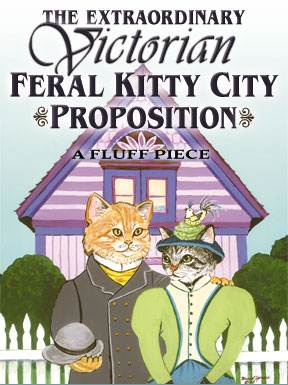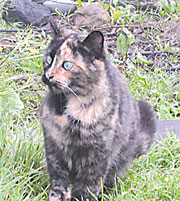|
COVER
STORY | IN THE NEWS | OPINION | DIRT December 8, 2005 |
|
"Hi kitty-kitty, hi there kitty," she says peeling back the aluminum lids. A brown tabby emerges from the hedge near the Eagle House Inn and meows. Another short-haired cat, white with some gray patches, follows behind but keeps its distance. MacMillan crouches down and plunks the cans of food onto a paper plate. Wet food is a treat these cats don't get every day, so they come running at the sound of it. The homeless tabby is near enough to touch, but MacMillan doesn't try. She puts a mound of kibble on another plate, collects the empty cans and brings them back to the truck to let Mercury and Lizzy have the leftovers. Now three cats hover over the wet food. (The shier ones will come out later when MacMillan is gone.) At this distance, they look like any old cats, ones that might roost on a sunny windowsill or lounge in a hamper of clothes. But these cats are far from housebroken. They're feral, felis catus, untouchable wild animals that were either left by their owners to fend for themselves or were born in the streets and have never lived with people. After a closer look, you can see that each cat has the tip of its right ear snipped off. It's a procedure veterinarians do to a feral cat that's gone through the TNR process -- trap, neuter, release. They also get vaccinated for rabies and other diseases. The tipped ear lets animal welfare workers like MacMillan easily identify strays that have not been fixed. There are feral cats all over Humboldt County, an estimated 60,000 of them. This year about 600 have gone through TNR. A small number of the cats that are trapped are tame enough to be adopted. Some of the wild ones live in managed colonies where someone, or a group of someones, feeds them daily. MacMillan is the executive director of the Sequoia Humane Society and she's also part of the Humboldt Spay Neuter Network, a volunteer group that traps and sterilizes feral cats to control overpopulation. She's one of four women who feed the Old Town ferals. Sunday is her day. She's been doing this for about two years now. "Of course there are times when I wake up Sunday and just feel like laying in bed and having my coffee," she said. "But when I come here and see them eating it makes me happy." |
|
It makes other people furious. Someone, or a group of someones, have regularly destroyed the small plywood cat-feeding stations by the Eagle House Inn. Another woman who feeds a colony of about 35 cats between H and I streets has been physically assaulted by a person angered by her work. A few years back a Eureka man poisoned cats in his neighborhood with antifreeze.
Some people assume feeding feral cats exacerbates
the problem. And that's true if you're feeding an unsprayed colony.
But for cats that have gone through TNR, feeding them actually
discourages them from getting in dumpsters. Also, a managed colony
usually polices their territory, keeping out newcomers and sick
cats, MacMillan said.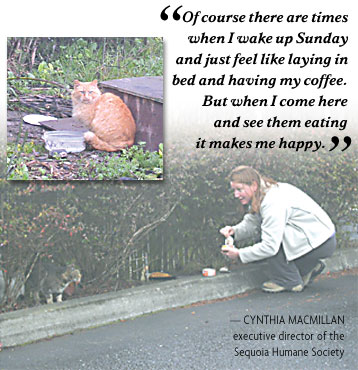
"With as much positive work that's done there are people who object to cats, and feral cats in particular, and try to harm them," she said. "Some people regard them as rodents."
MacMillan hops back in her truck and drives across the street to the H.H. Buhne warehouse. Before she's even come to a stop, Half-and-Half bolts out of a hole in the old tin building and scrambles toward the pickup. Her fur has a tortoise-shell pattern. One side of her face is orange and the other is black. Judging from her looks and the sag in her gut, MacMillan figures she's about eight years old and healthy. Half-and-Half's extremely social for a wild cat, so MacMillan calls her an ambassador kitty, a representative for the other ferals.
Right: Cynthia MacMillan, executive director of the Sequoia Humane Society, feeds feral cats in Old Town. A feral orange tabby waits outside of the Buhne to be fed.
"Half-and-Half, I see her every day," she said. "If I didn't I would worry. There's definitely a feeling of powerlessness that we have with this job. We've talked with the city about relocating [the cats] somewhere, with their safety in mind."
When discussions of demolishing or relocating the 103-year-old (and therefore historic and arguably significant, despite its dilapidated state) Buhne warehouse were being considered by the Eureka City Council and the Redevelopment Advisory Board in June, a cat welfare group, Feral Friends, sprang to action. Members of the organization, which serves as an umbrella group for other feline welfare nonprofits, talked with City Council members about finding a city-owned parcel where the cats could be transferred.
Since the Taxpayers' League's conflict-of-interest charges against developer Glenn Goldan were filed, plans to redevelop the Buhne lot have ground to a halt, possibly for a few years. In the interim, the eviction of the 12 to 15 cats at the warehouse has been postponed, but the women who tend to them are nevertheless exploring housing options.

THE PROPOSITION
Carole Beaton, co-founder of Bless the Beasts, can't remember who it was that first suggested building tiny decorative houses for the feral cats that live at the Buhne warehouse. But once she heard the idea she pounced on it.
Beaton is a pretty hyperactive 60-year-old, a Type A extrovert who talks in a stream of run-on sentences that eventually end in exclamation points. She retired early from teaching special education so she could dedicate all of her time to animal welfare causes, mainly spaying and neutering feral cats.
"Well, I walk a lot and I think -- you've
probably seen me -- I walk all over Eureka and look around at
the houses, and that's when I thought ... Victorian houses, wouldn't
that be cute! This is a Victorian place! I can just see little
old men in their garages building a darling little Victorian
house!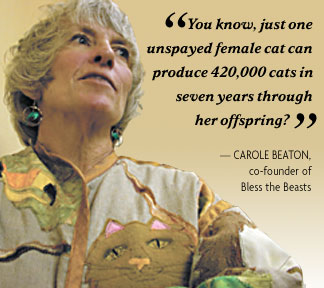
"Then someone wanted to call it the Victorian something or another and I came up with the name Victorian Kitty City because I thought that just kind of had a ring to it. I thought it could be replicas of real places. You can kind of just go sky high with something like this! I'm good at fundraising and organizing things and getting this kind of stuff together. But I'm not in a hurry to do this, my main thing is getting cats spayed and neutered and writing grants and that kind of stuff. So anyway, it just kind of came to me."
And while the Eureka City Council -- particularly Councilmember Mary Beth Wolford, whose ward covers Old Town -- have been responsive to the proposal of moving the Buhne cats to a new parcel, Beaton thinks it would be better to relocate them to private property. Private land would better protect the Victorian Kitty City from vandals, cat-haters and penny-pinchers.
"The thing is that the City Council all like the idea, but there is the Coastal Zone to deal with and it would cost the city money to give us a spot and go through all the paperwork," she said. "So we would have problems with people who don't like cats, and from the Taxpayers' League -- you know, people who don't want money spent on anything frivolous -- although I think in the long run it would be a tourist attraction! And I would rather not have to deal with the bureaucracy, to tell you the truth."
One spot that has been considered is the Blue Ox Millworks, a shop that specializes in Victorian architectural replications, among other things. It would be a perfect fit, because Blue Ox students could construct the Victorian Kitty City. Thing is, since the land around the Blue Ox's one-acre parcel was bought up by Rob Arkley earlier this year, it has been looking for a new home. Rumors are that the Blue Ox will move to Samoa, but owner Viviana Hollenbeck says the arrangements are still up in the air.
"[Blue Ox] is one full year in the process of looking [for a new site] and we're not any closer at this point," Hollenbeck said. "We're the people who like to say, `We can do that,' but I just can't talk about it now."
What is known is that Hollenbeck, who in her role as an "animal communicator" will be giving a talk at Arcata's Golden Harvest Café this week, has expressed interest in housing the Victorian Kitty City on Blue Ox's property, wherever and whenever that might be.
"She's really ecstatic about it," Beaton said.
The prospect makes feral cat enthusiasts like Beaton ecstatic, too. But at this point, it's a waiting game.
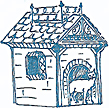
THE JETTY CATS
If Eureka eventually gets its feral kitty city, it won't be the first coastal town to do so.
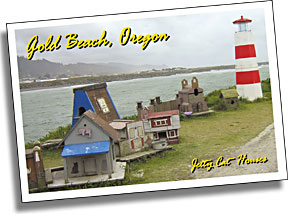 In
Gold Beach, Ore., about 100 miles from Eureka, Ursula Elliott
watches over 15 cat houses on the jetty, where 10 or 12 cats
get their food. For the most part, she said, they don't actually
sleep inside the houses, but stay in nearby caves created by
rocks on the shore.
In
Gold Beach, Ore., about 100 miles from Eureka, Ursula Elliott
watches over 15 cat houses on the jetty, where 10 or 12 cats
get their food. For the most part, she said, they don't actually
sleep inside the houses, but stay in nearby caves created by
rocks on the shore.
Elliott, her husband and some neighbors created a feral kitty city back in 1992 on the Gold Beach jetty, where a number of stray cats lived. The Elliots didn't wait to get the OK from the government to build on city land -- they just went ahead and did it.
Right: Cat houses on the jetty in Gold Beach.
The mariner-themed dwellings, among them a lighthouse and a boat, are a tourist attraction in the tiny town where people come to fish the Rogue River.
Elliott, who is now widowed and in her late 60s, said she will likely take care of the Jetty Cats for the rest of her life.
"Oh, I'm afraid I will," she said. "I think it is my destiny. I think this is what I am supposed to do."
Sounds like mystic talk, but the native of Germany stresses that she is not one of those women who pop up in the news from time to time for illegally boarding hundreds of cats at their homes.
"I am not the crazy collector," she said. "Those cat ladies keep the kitties. I adopt them out."
In observance of National Feral Cat Day in mid-October, Councilmember and cat-lover Mary Beth Wolford drove "all the way up there" to Gold Beach with her daughter to visit Elliott and the Jetty Cats, and to get an idea of what could some day be a reality in Eureka.
"I think the situation is very cute," Wolford said. "I definitely think Eureka could do this. It would help cut down on the population of feral cats. The taxpayers end up paying the costs of having the cats picked up when they produce kittens so frequently because animal control has to trap them, euthanize them or care for them.
"I think this would help our community. If the cats had a facility, they wouldn't scatter way out. They like it in one place."
The City Council has considered giving the Victorian Kitty City a small plot next to the Wharfinger Building, one too small to build much of anything on.
"I think that some people feel that this is not a worthwhile project to give city support for, and I disagree," Wolford said. "I think it would be a very good project for some of our young people involved in the Blue Ox to build some of these little Victorian houses and paint them and put their names on a plaque."
Wolford is a member of the Eureka Heritage Society and lives in an Old Town Victorian, built in 1885, that used to be a bar and a brothel.
"I think it would be neat to have tiny replicas of the Carson Mansion and the Pink Lady," she said.
What about replicating her house, for that matter?
"Oh I don't know about that," she said. "But did you see my Christmas lights?"

MILLION-DOLLAR LADY
Gathering cash to spay, neuter and vaccinate feral cats is a constant battle for the volunteer groups. Already they get a discounted rate with three area veterinarians -- $30 to neuter, $45 to spay. Sometimes they ask for a co-payment from the people who bring a colony of ferals to their attention. They can get people in Arcata and more affluent places to pitch in sometimes, but often, in more rural areas like Rio Dell, people don't have the money to spare.
"We just don't expect a poor elderly lady to cough up $20 per cat when she's got 10 feral cats in her backyard because somebody dumped them there," said Alice Millington, co-founder of Bless the Beasts and a Rio Dell resident.
So Bless the Beasts, Humboldt Spay Neuter Foundation, Feral Friends or whatever other group with some spare money will cover the costs with their grant funding. Last year they received $10,000 from PetSmart and $7,000 from the Marie Raleigh Trust through the Humboldt Area Foundation. A recent fundraiser -- the Spayghetti and No Balls Feed -- raked in another $7,000. But it's never enough money.
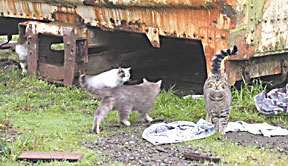 Beaton
and the other volunteers realize fighting pet overpopulation
is an uphill battle. But if they're feeling discouraged, they
don't show it.
Beaton
and the other volunteers realize fighting pet overpopulation
is an uphill battle. But if they're feeling discouraged, they
don't show it.
Left: Feral cats outside of the Buhne warehouse wait to be fed.
"You know, just one unspayed female cat can produce 420,000 cats in seven years through her offspring?" Beaton said at a recent Fixer Mixer at the Sequoia Humane Society. "For me, with every female cat I trap I feel like I really make a difference. It's a real sense of victory!
"And it's great to work with all these wonderful people," she added, pulling Humboldt Spay Neuter Network President Jennifer Raymond into the conversation.
"Yeah, we like to get together in alleys, hang out next to dumpsters," Raymond said, getting a laugh out of Beaton.
Financial hardships come with the territory, although they both say that with more money feral cats would not be so rampant.
In 1999 a national grant called Maddie's Fund dispersed $20 million to spay and neuter feral cats across the country. In the years that funding was available, veterinarians were able to write-off the entire cost of the surgery and get reimbursed through Maddie's Fund.
Humboldt County had one of the highest animal sterilization rates per capita in California.
"It just goes to show you how organized the people who care about animals around here are," Raymond said. "When we're given an opportunity we really make the best of it."
Now that the grant has run its course, fewer cats can get in to area vets, who lose money by performing the surgery at a discounted rate.
But in the near future another lump sum is expected to materialize. A Humboldt County resident in her 90s has willed $5 million to the Humboldt Area Foundation to be used for spay/neuter programs for cats and dogs.
"It's not a secret at all," Beaton said. "Whenever we'd call over [to the Humboldt Area Foundation] they'd tell us about the $5 million dollar lady. We've known about it for several years but she hasn't died yet."
Beaton and Raymond said the woman is ill with Alzheimer's. But the Humboldt Area Foundation could not elaborate on the woman's health condition or provide her name.
"I think we can say that we are expecting additional dollars in the future that are part of an estate plan and we also have several funds at present and that at some point we might really be able to solve the [pet overpopulation] problem in Humboldt County," said Alex Reid, director of donor services for the Humboldt Area Foundation.
Beaton said that at this point, Feral Friends and the other dozen or so animal welfare groups in the county are well-oiled machines. Were the five million dollar lady to die five years ago, they wouldn't have been as prepared to handle the funds as they are now.
"We're ready now, we're really prepared to get this money," she said.
Their first course of action would be to hire a veterinarian just for feral cats.
PRIDE OF OWNERSHIP
The abandoned railroad cars at the edge of Old Town are MacMillan's final stop of the morning. Cats live beneath and possibly inside the boxcars. Like the Buhne warehouse, the cars are just rusting relics that are steadily becoming an eyesore.
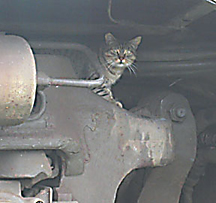 The area is strewn with wet blankets
and other detritus accumulated into crude encampments where people
sleep.
The area is strewn with wet blankets
and other detritus accumulated into crude encampments where people
sleep.
"They sleep inside some of the cars, too," MacMillan said.
A gray tabby meows loudly to get MacMillan's attention. "Whoa, I hear you," she said, cracking open the last of her 24 cans of cat food this Sunday. "We should really come up with a name for that one."
Four or five cats whirl around each other underneath the boxcar and jockey for the plate. One is Siamese, with blue eyes that are sort of crossed. At the right angle she looks like Barbra Streisand, sort of pretty in a funny kind of way. Let your imagination wander and she's singing "Memories" from the balcony of a Victorian cathouse.
As the kitties chow down, a man in scruffy clothes and a blue knit cap walks past, glancing at the cats and smiling with some effort. He and MacMillan exchange good-mornings.
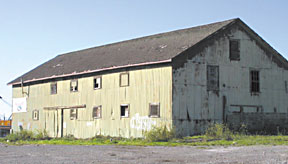 "Most
of the people here are nice; they tell us we're doing a good
job," she said.
"Most
of the people here are nice; they tell us we're doing a good
job," she said.
Right: The H.H. Buhne warehouse at the foot of C Street, Eureka.
On its surface, it seems heartless to be worrying about feral cats when there are people living in the very same conditions. But MacMillan doesn't make apologies.
"I've chosen to focus my efforts on saving animals because that's my calling," she said. "These particular cats stopped being cared for and they're here because people left them here. Caring for homeless people is not what I'm emotionally tied to."
As she gathers the cans and gets ready to leave, MacMillan spots a brown tabby that looks a lot like the others she fed today. But this one is cautious. He hides in the steel framework of the train, watching the other cats feed. He'll likely be here for a couple more years, but you can almost picture him, this streetwise fellow, stretched out on the porch, admiring the filigree of his own little home.
COVER
STORY | IN THE NEWS | OPINION | DIRT
TALK OF THE TABLE | THE HUM | CALENDAR
Comments? Write a letter!
© Copyright 2005, North Coast Journal, Inc.

